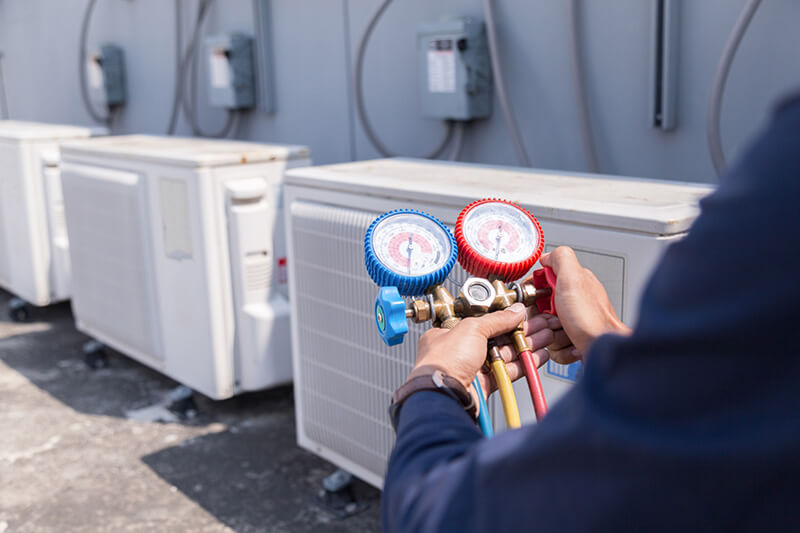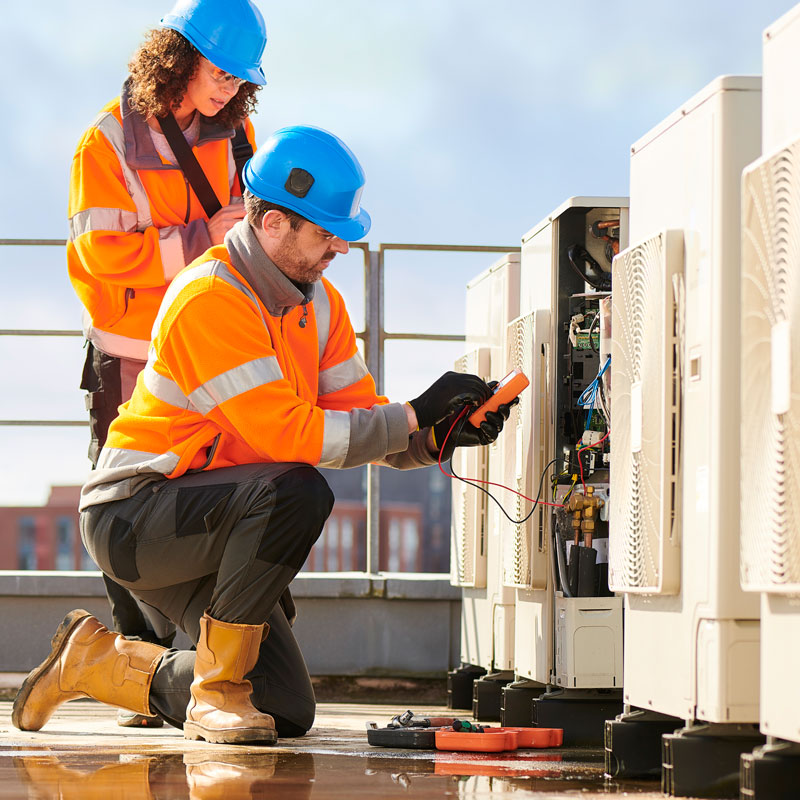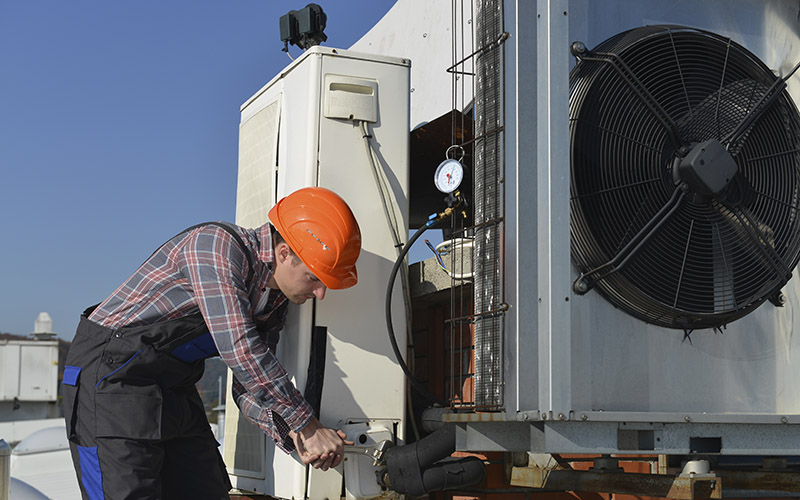Just How a Heatpump and Furnace Interact to Optimize Your Home's Heating Efficiency
Recognizing just how a heatpump and heater interact is necessary for house owners looking for effective heating services. Each system has its strengths, giving a well balanced approach to home convenience. The heatpump succeeds in modest temperatures, while the heater provides rapid heat during extreme cold. This synergy not just decreases power prices but likewise improves the life expectancy of both devices. What variables affect this partnership, and exactly how can property owners maximize their benefits?
Comprehending Warm Pumps: Exactly How They Function
Many individuals may be unfamiliar with their internal functions, heat pumps play an essential function in modern-day home heating systems. These tools run by transferring warm from one location to another, utilizing the concepts of thermodynamics. In colder months, a warm pump removes warm from the outdoors air, ground, or water, and transfers it inside your home to warm up the space. Alternatively, throughout warmer months, it can turn around the procedure, functioning as an a/c by removing warmth from inside to the outside.Heat pumps contain an evaporator, development, compressor, and condenser shutoff. The cooling agent within the system takes in warm as it evaporates at reduced temperature levels and pressures. The compressor then boosts the pressure and temperature level of the refrigerant, permitting it to launch warmth as it condenses. This efficient process can considerably minimize power consumption compared to typical home heating techniques, making heat pumps a sustainable option for environment control in homes.
The Role of Heaters in Home Home Heating
Heating systems play a necessary duty in home heating by providing a trusted source of warmth throughout the cooler months. They operate by creating warmth via burning or electrical resistance, distributing it throughout the home via air ducts or radiant systems. The effectiveness of a furnace is typically determined by its Annual Gas Utilization Efficiency (AFUE) ranking, which suggests exactly how successfully the unit transforms gas into heat.Furnaces can make use of different energy resources, including natural gas, electricity, propane, or oil, allowing property owners to choose the most appropriate option for their requirements. Unlike warm pumps, which may battle in severe cold, furnaces maintain constant performance, ensuring that interior temperature levels stay comfy regardless of outdoor problems. In addition, modern-day heating systems usually come outfitted with advanced innovation, such as wise thermostats and variable-speed blowers, improving their effectiveness and responsiveness. This convenience makes furnaces an essential part in all-inclusive home heating techniques.

Benefits of Making Use Of Both Solutions Together
Incorporating the staminas of both furnaces and heatpump can bring about an extra effective and reliable home heating remedy. Using both systems enables homeowners to take advantage of the heatpump's energy effectiveness throughout milder temperature levels while relying on the furnace for even more severe cold problems. This double strategy can considerably decrease power prices, as heatpump consume less electricity than standard home heating approaches when temperature levels are moderate.Additionally, using both systems together can enhance convenience levels in the home. Heat pumps can give consistent, also home heating, while furnaces can quickly raise ambient temperature levels when needed. In addition, the combination of both systems can expand the lifespan of devices by decreasing damage on each unit, as they share the workload. Ultimately, homeowners can appreciate a well balanced, affordable heating service that changes perfectly to differing climate condition, making sure a warm and welcoming home throughout the winter season.
Exactly How Warmth Pumps and Furnaces Complement Each Other
When house owners incorporate heat pumps and heating systems, they produce a corresponding heater that maximizes performance and convenience. Heatpump run by moving warm from the outdoors air or ground, making them very efficient in modest climates. They excel during milder temperature levels, giving affordable heating. On the other hand, furnaces generate warm through burning or electric resistance, providing solid, instant heat throughout extreme cool conditions.The combination of these two systems enables for vibrant adjustments based upon temperature variations. Throughout warmer months or milder winter days, the heatpump can take the lead, saving energy and decreasing costs. As temperatures decline, the heater can perfectly involve, making sure constant warmth throughout the home. This harmony not just maximizes energy usage yet additionally enhances the life-span of both systems, as each system runs within its suitable efficiency variety. With each other, they produce a balanced atmosphere that adjusts to differing climate demands.
Maximizing Effectiveness: Tips for Homeowners
Property owners can boost their heating performance with a number of sensible approaches. Developing a normal upkeep routine, incorporating wise thermostat innovation, and carrying out efficient insulation and sealing services are crucial steps. These procedures not only improve convenience however likewise decrease energy prices.
Regular Maintenance Schedule
To ensure optimal home heating efficiency, establishing a regular maintenance schedule is necessary for any kind of home. House owners need to prioritize regular examinations of both heat pumps and furnaces to ascertain peak efficiency. This consists of changing air filters each to three months, as clogged filters can greatly reduce efficiency. In addition, scheduling specialist upkeep a minimum of yearly enables professionals to identify and address potential concerns prior to they intensify. Property owners must also cleanse the heatpump's outside system to avoid particles accumulation that can prevent air flow. By sticking to a routine maintenance schedule, house owners not just improve their heater' performance however also extend their life-span, causing higher comfort and minimized power costs throughout the chillier months.
Smart Thermostat Assimilation
Integrating a smart thermostat right into a home heater can significantly boost energy efficiency, specifically as it permits accurate control over temperature settings. These gadgets can learn the home owner's schedule and choices, automatically readjusting the temperature to optimize comfort while minimizing energy use. For circumstances, they can reduce home heating during times when the home is unoccupied, reducing unneeded usage. Lots of clever thermostats likewise supply real-time energy usage data, allowing homeowners to make educated decisions concerning their home heating behaviors. Additionally, remote access via mobile phone apps allows users to change setups from anywhere, making certain the home is warm upon return. In general, smart thermostat combination not only improves convenience however considerably contributes to power savings go to this site and efficiency.
Insulation and Securing Solutions
Smart thermostats play an important function in power efficiency, but their efficiency can be greatly enhanced by appropriate insulation and sealing solutions. Home owners ought to focus on insulating attic rooms, walls, and floorings to decrease heat loss. Top quality insulation products, such as spray foam or fiberglass, can significantly boost thermal resistance. Additionally, sealing spaces around air ducts, home windows, and doors protects against chilly air infiltration and warmth escape. Weatherstripping and caulking work methods for addressing these leakages - furnace replacement. Regular inspections for air leaks, in addition to making use of blower door examinations, can help recognize problem locations. By buying insulation and sealing, homeowners can enhance the efficiency of their furnace, ultimately bring about minimized power usage and reduced utility costs
Typical Myths Concerning Warmth Pumps and Furnaces
What misunderstandings border heatpump and heating systems? Lots of individuals mistakenly think that heatpump are ineffective in colder climates. Actually, modern-day warm pumps are made to run efficiently also in reduced temperature levels, offering dependable home heating throughout winter. Another common myth is that furnaces are always more effective than heat pumps. However, this depends on the specific power resources and effectiveness ratings of the systems concerned. Some may also think that utilizing both systems all at once is unneeded, but as a matter of fact, this mix can optimize home heating performance, especially throughout severe weather. Additionally, individuals frequently assume that heat pumps need continuous upkeep, when in truth, they have click to find out more similar upkeep requires to traditional heating systems. By disproving these misconceptions, property owners can make even more enlightened decisions regarding their heating alternatives, inevitably resulting in boosted comfort and power efficiency in their homes.
Maintenance Considerations for Combined Solutions

Regularly Asked Concerns
Can Warm Pumps Job Properly in Extremely Cold Climates?
Warmth pumps can battle in incredibly chilly environments because of reduced efficiency and heat removal limitations. Innovations in innovation have actually led to designs made for better efficiency in such conditions, boosting their feasibility in harsh settings.
For How Long Do Warmth Pumps and Furnaces Generally Last?
Heatpump normally last 15 to two decades, while furnaces have a lifespan of 15 to three decades. Regular upkeep can extend their long life, making certain reliable operation and minimizing the demand for early substitutes.

What Is the Average Cost of Installing Both Equipments?
The typical expense of installing both a heat pump and a furnace commonly ranges in between $5,000 to $10,000 - ductless mini splits. Aspects influencing this price consist of system dimension, setup intricacy, and regional labor prices
Are There Tax Obligation Motivations for Using Energy-Efficient Heating Systems?
Lots of property owners make inquiries about tax rewards for energy-efficient heater. Different government and state programs often provide debts or discounts, encouraging the adoption of sustainable technologies to reduce power intake and advertise ecological obligation.
Exactly how Do I Pick the Right Size Heatpump and Furnace?
Picking the ideal dimension heat pump and heating system involves determining the home's square footage, taking into consideration insulation top quality, and evaluating local environment. Consulting a professional can guarantee suitable system efficiency and energy efficiency based upon specific demands. heat pump installation ooltewah tn. Understanding just how a heat pump and heater work together is necessary for home owners looking for reliable home heating solutions. In cooler months, a warmth pump essences heat from the outside air, ground, or water, and transfers it inside to heat the living space. When homeowners incorporate warmth pumps and heating systems, they create a corresponding home heating system that makes best use of performance and comfort. Warmth pumps run by transferring warmth from the outdoors air or ground, making them highly reliable in moderate climates. Warm pumps can struggle in exceptionally chilly climates due to lowered effectiveness and heat removal limitations